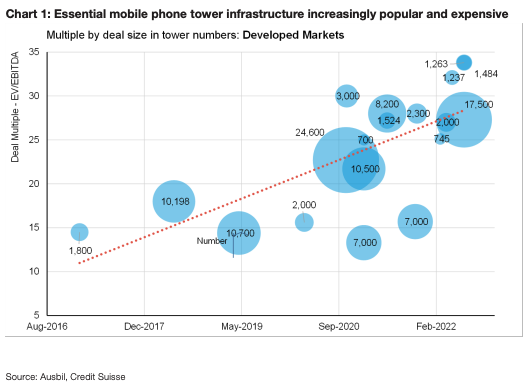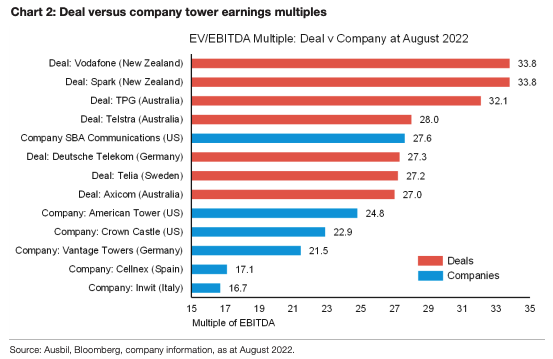Communication towers: Why are they so exciting?
Mobile phone towers might not strike investors as too exciting until they look at the fundamentals and growth outlook for this vibrant sector.
In this piece, Natasha Thomas, Portfolio Manager, Energy & Communications at Ausbil Global Infrastructure, shares the compelling opportunity in communications infrastructure.
Back to basics, what exactly does a communication tower or mobile phone tower company do?
A mobile phone tower is a vertical structure built on a parcel of land. This structure, and the ground interest on which it stands, is typically owned or leased under a long-term contract by the mobile phone tower company. The mobile phone tower company then leases the vertical space on the tower and portions of the land at the base of the tower to tenants, primarily telecom service providers. Most towers have the capacity to support 4 to 5 communication’ tenants. The tenant owns and is responsible for operating and maintaining the equipment that they install on the tower, not the infrastructure operator, including antennas and coaxial cables, as well as the equipment shelters at the base of the tower. This means that there is significantly less risk in owning the infrastructure as any problems with the wires and boxes are for the telecom service provider leasing the space.
Why do mobile phone tower companies fit our definition of Essential Infrastructure?
The characteristics of the mobile phone tower industry fit squarely within Ausbil’s strict definition of Essential Infrastructure. The reason for this is two main characteristics that can be observed in these tower assets.
The first characteristic is the asset’s strong recurring cash flow characteristics. The contracts between the tower companies and their telecommunication company tenants are long-term and cannot be cancelled. In addition, they have annual price escalators (clauses that allow for increases to agreed fees) embedded in these contracts providing inflation protection (we talk more about this later). Incremental cash flow margins are high, as adding new customers to an existing tower comes with little to no additional operating cost, and maintenance capex is low.
The second characteristic that for us determines that towers are Essential Infrastructure is the high
barriers to entry. The towers are a location-based business, typically with significant zoning restrictions.
Coupled with the capital and time required to build-out a tower network of meaningful scale, it would be
very challenging for a new entrant to start up and replicate an existing tower network. This helps drive
high contract renewal rates by the tenants on the towers.
If towers are so good, why are telecommunications companies selling them?
We have seen increased and ongoing capex requirements by the telecom service providers in order for them to secure spectrum and build out their 4G (and now 5G) networks (for more on 5G click here). Because of this ramp-up in capex requirements, the telecom service providers have looked at the returns of their tower assets, which have been largely below their cost of capital, and monetised these assets through listing or selling them so they can recycle their capital back into their core businesses. The European tower industry in particular has seen a large amount of consolidation over the past five years, with European operators under financial pressure to continue selling towers. The move towards the shared tower model offers a more efficient use of capital for telecom providers. Under the shared-tower model, multiple tenants lease vertical space on the tower for their communications equipment instead of owning or leasing single-tenant towers, effectively sharing the operating costs of running the tower.
This shakeout of towers from telecoms has seen a significant number of tower infrastructure deals hit the
market, as illustrated in Chart 1. This has culminated in an upward valuation trend as investors recognise
the inherent value in tower ownership, and its multi-tenant income streams.

Why do you think private equity is increasingly involved in buying towers?
There are a few drivers at play here. Private equity has been involved in the tower space for a long
time, largely due to the strong investment characteristics that make the mobile phone towers fit our
definition of Essential Infrastructure. They are also able to take advantage of these strong characteristics
when it comes to leverage and can ascribe more debt to these assets than the listed market typically
wants to see. The interest rate environment we have experienced over the last few years would have
enabled private equity to access debt for tower assets at very low levels, thus making them very attractive
investments. More recently, listed tower companies across the globe have underperformed this year
relative to other Essential Infrastructure companies (along with other long duration assets) on the back of
rising interest rates and inflation expectations. We think private equity has been able to take advantage
of the short-term market dislocation and have been willing to pay a premium for tower assets over the
listed mobile tower company valuations, helping them to win more transactions recently versus the listed
tower companies.
How do the multiples being paid by private equity compare to the multiples for related listed companies?
We have seen private equity invest in the space with bids for tower assets in the mid-to-high 20x
EBITDA range in Europe, and the high 20x to low 30x range in Australia and New Zealand, as illustrated in
Chart 2. In 2021, we saw Telia in Sweden sell a minority stake in some of its tower assets for around 28x
EBITDA to a consortium of Brookfield and Alecta. More recently in July 2022, Deutsche Telekom sold a
51% stake in its tower assets in Germany and Austria at a valuation of 27x EBITDA to a consortium made
up of Brookfield and Digital Bridge. These deals highlight that the listed names trading in the low-20 times
2023 EBITDA are much cheaper than the deals being written in the unlisted market. This arbitrage may
lead to a takeout by private equity, which will be to the ultimate benefit of listed investors.

Does rising rates and private equity involvement in towers suggest tower companies are going to struggle to compete for assets?
There remain numerous opportunities for listed tower companies to acquire tower assets from mobile
phone operators around the world despite rising rates and private equity. In Europe alone, Credit Suisse
has identified over 100,000 towers that could change hands from operators to independent tower
companies in the near-term. While valuation is clearly a key component of any transaction, other deal
terms also need to be considered to ensure the transaction is a strategic fit for the tower company. The
recent transaction with Deutsche Telekom Tower (DTT) selling a stake in its tower assets in Germany
and Austria is a prime example. As part of the deal, DTT has buyback rights after 5-years, allowing it to
repurchase shares at a premium and then reconsolidate their operations if it is of benefit to their profit
outlook. Moreover, some 10% of sites were designated “golden” sites where secondary tenants are not
allowed, despite being very attractively positioned towers. These terms are unique to this deal and likely
less attractive to an operator-led acquisition (like Cellnex) given the potential for the acquirer to relinquish
majority control of the assets in the future, and the reduced potential for the shared tower model and
associated revenue opportunities.
Besides M&A, are there organic growth opportunities in the listed tower sector?
Exponentially growing data demand around the world is expected to drive continued organic growth opportunities for all tower companies. According to Ericsson, total global mobile data traffic reached around 67EB (exabyte) per month by the end of 2021 and is projected to grow by a factor of around 4.2 to reach 282EB per month in 2027. Telecom service providers are increasingly having to spend capital to densify and improve their networks. This involves upgrading or adding equipment to existing towers, often at little to no cost to the tower company, as well as adding new tower sites to their networks. As we see networks evolve into 5G and beyond, large macro tower sites are expected to continue providing the blanket coverage for users on the move, while other densification solutions including small cells and distributed antenna systems (DAS) will complement the coverage provided by towers in urban locations. The tower companies are increasingly looking to invest in these densification solutions, including small cells, fibre, and edge computing, in order to offer a more complete service to their customers.
A number of deals over the last few years, especially in Europe, have seen mobile phone operators sell-off
their tower assets to independent tower companies with a capital investment build-to-suit (BTS) program
agreement attached. The agreement sets out a comprehensive plan for new tower infrastructure sites to be
built by the tower company, enabling the mobile phone operator to solely focus its investments on its mobile
phone network.
What attractive investment opportunities are you seeing in the global listed tower sector?
Across the sector there is a multiplicity of attractive investment opportunities, so instead of going through
them all, we’ll focus on two. Firstly, Spanish-listed mobile phone tower company Cellnex Telecom SA (BME:
CLNX) owns and operates over 116,000 mobile phone tower sites in 12 countries across continental Europe
and the United Kingdom. Cellnex has emerged as the leading independent tower company in Europe after
conducting numerous tower acquisitions from telecom service providers over the last 5 years, with some of
their key transactions shown in Table 1. These deals include both the initial towers acquired as well as organic
BTS programs agreed as part of the transaction.

Cellnex has remained disciplined when executing M&A, and has walked away from deals that did not fit its strategy or include attractive contractual agreements to lease the space on the towers back to the telecom service provider. As at 30 June 2022, Cellnex estimated it had €6.5bn in future capital spending to complete the BTS programs agreed when the assets were acquired from the telecom service provider. Cellnex will benefit from the co-location of adding new customers to both the existing and BTS towers, as well as from the increased spending of the telecom service providers as they build-out their 5G networks, and eventually, 6G, 7G… and so on.
Secondly, in the US, SBA Communications Corporation (NASDAQ: SBAC) is a leading independent owner
and operator of wireless communications infrastructure including towers, buildings, rooftops, DAS and small
cells. SBA has made a modest expansion into Latin America, and has recently entered Asia and Africa, but
for the most part, it has remained focused on the US market where it is benefitting from the acceleration in
deployment of 5G by its tenants.
Given the macroeconomic backdrop, what is your outlook for the sector?
The global economy is showing signs of a slowdown and if we are going into a slowdown, our proprietary macro and top-down analysis shows that the tower companies have historically been the best performing Essential Infrastructure sector during these times. This is because the tower companies benefit from price escalators in their contracts which can be either inflation-linked or through a fixed escalator. These escalators cover the cost escalation of ground leases, which are the vast majority of a company’s operating costs. The ability to absorb and pass on rising prices is very attractive in the current inflationary environment. The listed tower companies have predominantly long-term fixed rate debt and, as discussed earlier, significant longerterm organic growth opportunities from the roll-out of 5G.
In terms of markets, the European tower market, especially, remains attractive because there are still multiple M&A opportunities through mobile phone operators selling-off their tower assets to the independent tower companies which could provide synergy, BTS and lease-up opportunities. In the US, towers are benefitting from increased activity from carriers that are deploying new spectrum to support new 5G networks, resulting in increased revenue at little to no additional cost to the tower company.
Ausbil is currently well positioned in the mobile phone tower sector, and we viewed the share price
underperformance at the start of 2022 as an attractive opportunity, adding to our tower portfolio.
Fundamentally, with the multi-tenant economics, the ability to pass inflation through to customers, and the
burgeoning demand for wireless connectivity, we see towers as one of the sectors offering true long-term
compounding opportunities for infrastructure investors that can perform across the cycle.
Invest in stable cash flow assets
Ausbil invests in securities that have assets that are essential for the basic functioning of a society. To find out more, click the 'FOLLOW' button below.
3 topics

